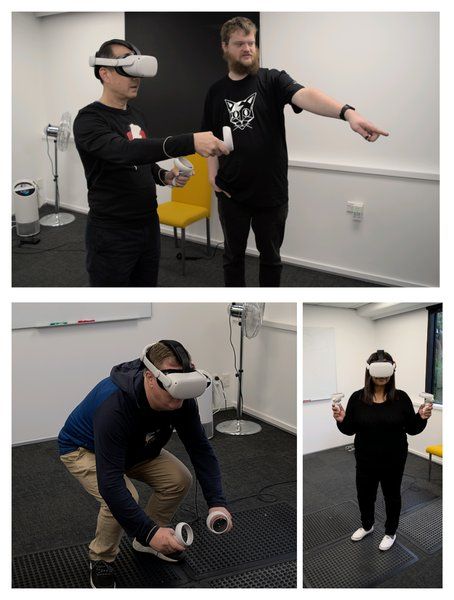Virtual reality is a technology that allows you to be anyone, do anything, or go anywhere you can possibly imagine without ever needing to leave the room. It's a digital technology that will enable you to step inside a piece of content, inside of a video game, or be part of a film.
If you have ever seen Ready Player One then you probably know what virtual reality is already or at least the dystopian future of virtual reality.
During the last two Catathon days at Catalyst I hosted a virtual reality event, giving people an opportunity to experience virtual reality (VR) for the first time.

Catalystas try out VR at Catathon
What is Virtual Reality?
There are three key components that are required to create a good VR experience:
- Hardware
- Trackability
- Interactivity
The hardware part is pretty straightforward. Most VR headsets have two lenses and a digital screen inside that that completely covers the eyes for an immersive 3D experience.
The second part is trackability. You have to be able to move around in the VR experience, which makes it an immersive experience compared to a video game or film. VR headsets use some combination of accelerometer, gyroscope, magnetometer, and proximity sensor to detect the user's motion.
Quick side note: early VR headsets had a delay in the tracking of the headset which caused nausea. So if you haven't tried VR in a while or the first time you tried it, it made you sick, I recommend you try it because technology has advanced and no longer causes nausea.
The third component is interactivity. Using controllers or even your hands in some fancier systems, you have the ability to do things inside of a VR experience. That interactivity is key in helping create a sense of immersion inside of a VR experience.
Virtual Reality Timeline
Virtual reality has been around since the 1940s, believe it or not. People have been working on this technology for a really long time.
However, it wasn’t until 2012, that a (at that time) little company called Oculus turned to crowdfunding to finance their developer kit, which would give the technology to developers who could integrate VR into their games.
However, just in the last half a decade the technology has improved massively! You don't need a big heavy-duty computer any more or hang a bunch of crazy sensors around your room.
All you need is a headset, a couple of controllers, and plenty of time to lose yourself in the amazing experiences that are available on these headsets.
Use Cases for the Technology
The first one that most people think about is gaming. Stepping inside of a video game is a pretty cool thing to do.
However there are some bigger more important use cases for this technology; we are seeing it save hundreds of thousands of dollars in the real world, in training and simulation.
Delivery companies are using this technology to train their drivers. The military has been using this for years to train soldiers, pilots, and the like. Training and simulation are great to use cases for this technology.
It also has huge benefits as a sales and marketing tool. Let's say you're an architect and you want to show someone what the inside of your new building looks like. Well, that’s hard to do until you actually build the building. With VR you can now do that.
Open Source Virtual Reality
Open Source has been a major part of Virtual Reality since the beginning and while lately lots of the bigger names in VR have been moving away from open source sadly.
There are still lots of frameworks, libraries, and tools that are Open Source which lowers the cost for developers and startups. Some of them are backed by companies like Google, and Mozilla, and supported by powerful communities.
In my opinion, one of the coolest Open-Source projects in VR is Relativty. It is an Open-source project helping developers to build their own VR hardware for less than $200. The project is providing 3D model sets, schematic, and instructions to assemble a VR headset.
Relativty uses Arduino, among many other open-source tools and libraries like OSVR to build high-quality low-cost headsets.

